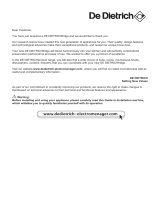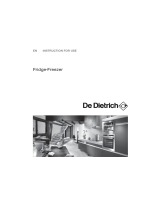
Instructions for Use 3
• Check periodically if adequate ventilation is
allowed (undisturbed circulation of air through
the bottom rail openings).
• Use higher thermostat settings only when
required or recommended.
• Before putting fresh food into the appliance, let
the food cool down to room temperature.
• A layer of ice and frost will increase energy
consumption. Therefore, clean the appliance as
soon as the layer is 3-5 mm thick.
• If the gasket is damaged or if it does not provide
a tight seal, the energy consumption will be
substantially higher. To restore efficiency,
replace the gasket.
• Condenser at the bottom of the appliance must
always be clean and free of dust (see section
Cleaning of the Appliance
).
• Always comply with the instructions in sections
Positioning and Energy Saving Tips; otherwise
the energy consumption may be substantially
higher.
Important
• This appliance can be used by children aged
from 8 years and above and persons with
reduced physical, sensory or metal capabilities
or lack of experience and knowledge if they have
been given supervision or instruction concerning
use of the appliance in a safe way and
understand the hazards involved. Children shall
not play with the appliance. Cleaning and user
maintenance shall not be made by children
without supervision.
• If you bought this appliance to replace an old one
that was equipped with a lock that cannot be
opened from inside of the appliance (lock, bolt),
make sure that the lock is broken. This will make
it impossible for children to lock themselves
inside the refrigerator and suffocate.
• The appliance must be correctly connected to
the power mains (see: Connecting to the Power
Mains).
• Do not touch the cooled surfaces while the
appliance operates, especially not with wet
hands, because the skin may stick to the cold
surfaces.
• Do not freeze bottles containing liquid, especially
not soft drinks, such as mineral water, sparkling
wine, beer, cola etc., because liquid expands
during freezing and the glass bottle is very likely
to blow up.
• Do not eat frozen food (bread, fruit, vegetables),
because you can get frostbites.
• If the food has strange smell or colour, throw it
away, because it is very likely that it is spoiled
and therefore dangerous to eat.
• Disconnect the appliance from the power supply
before repairing it (only a qualified technician
should repair it), before cleaning and before
replacing the light bulb.
• Do not defrost the appliance with other electric
appliances (as for example with hair dryer) and
never scrape the frost layer with sharp objects.
Use only enclosed tools or tools recommended
by the manufacturer.
• To protect the environment, be careful not to
damage the rear wall of the appliance (the
condenser unit or the tubes, for example when
moving the appliance) or any part of the
refrigeration system inside the appliance.
• The refrigeration system of the appliance is filled
with refrigerant and oil. When the appliance is
damaged, handle it with care and dispose it of in
compliance with environment-protection
regulations (see We Care for the Environment).
• If the supply cord is damaged, it must be
replaced by the manufacturer, a service agent or
other qualified person in order to avoid hazard.
• The rating plate is located inside the appliance or
outside on the rear wall.
• Warning! Ventilation
slots on the appliance
or a built-in element
must always be clean
and unobstructed.











